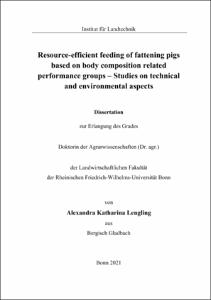Lengling, Alexandra Katharina: Resource-efficient feeding of fattening pigs based on body composition related performance groups : Studies on technical and environmental aspects. - Bonn, 2021. - Dissertation, Rheinische Friedrich-Wilhelms-Universität Bonn.
Online-Ausgabe in bonndoc: https://nbn-resolving.org/urn:nbn:de:hbz:5-63953
Online-Ausgabe in bonndoc: https://nbn-resolving.org/urn:nbn:de:hbz:5-63953
@phdthesis{handle:20.500.11811/9378,
urn: https://nbn-resolving.org/urn:nbn:de:hbz:5-63953,
author = {{Alexandra Katharina Lengling}},
title = {Resource-efficient feeding of fattening pigs based on body composition related performance groups : Studies on technical and environmental aspects},
school = {Rheinische Friedrich-Wilhelms-Universität Bonn},
year = 2021,
month = oct,
note = {Livestock husbandry is increasingly confronted with the growing demands for more animal welfare and better environmental protection. As the largest component of agricultural animals in meat production, fattening pig husbandry plays a particularly important role. The high protein input in the feeding of fattening pigs leads to an excess of nitrogen being released into the environment. Stricter regulations regarding nitrogen inputs, as well as international agreements to reduce ammonia emissions, require new feeding strategies for fattening pigs. Feeding according to nutritional requirements is desirable and necessary in terms of resource efficiency and animal welfare as well as from an economic point of view. The aim of this dissertation is therefore to investigate and evaluate a new resource-efficient feeding concept for fattening pigs with regard to the environmental impact and technical aspects of implementation.
Study 1 and 2 of this thesis dealt with the questions if fattening pigs can be divided into performance groups on the basis of body condition, and if their feed intake can be controlled by different fiber contents in the diet. Additionally, the influence of fiber supplemented feeding on ammonia emissions and floor pollution in the barn was investigated. Results showed that by means of ultrasound examinations different performance groups can be distinguished on the basis of the back fat to back muscle ratio. The feed intake correlated negatively with the crude fiber content in the diet, so that the feed intake could be controlled via the crude fiber content. At the same time, ammonia emissions were reduced and no increase in floor pollution was observed.
Study 3 dealt with the question whether different body conditions lead to differences in body surface temperature, which can be made visible by using infrared thermography. It was further investigated whether it is possible and technically feasible to differentiate performance groups based on the thermographic images. The back fat thickness correlated negatively with the body surface temperature. However, it was not possible to differentiate between the individual performance groups on the basis of the thermographic images.
This dissertation provides important insights into the individual differences in the needs and development potential of fattening pigs and how these can be technically taken into account in feeding. It also provides first approaches for the application of infrared thermography in the feeding of fattening pigs. The results of the studies show that resource-efficient feeding of fattening pigs is technically possible and desirable in terms of animal welfare and environmental protection.},
url = {https://hdl.handle.net/20.500.11811/9378}
}
urn: https://nbn-resolving.org/urn:nbn:de:hbz:5-63953,
author = {{Alexandra Katharina Lengling}},
title = {Resource-efficient feeding of fattening pigs based on body composition related performance groups : Studies on technical and environmental aspects},
school = {Rheinische Friedrich-Wilhelms-Universität Bonn},
year = 2021,
month = oct,
note = {Livestock husbandry is increasingly confronted with the growing demands for more animal welfare and better environmental protection. As the largest component of agricultural animals in meat production, fattening pig husbandry plays a particularly important role. The high protein input in the feeding of fattening pigs leads to an excess of nitrogen being released into the environment. Stricter regulations regarding nitrogen inputs, as well as international agreements to reduce ammonia emissions, require new feeding strategies for fattening pigs. Feeding according to nutritional requirements is desirable and necessary in terms of resource efficiency and animal welfare as well as from an economic point of view. The aim of this dissertation is therefore to investigate and evaluate a new resource-efficient feeding concept for fattening pigs with regard to the environmental impact and technical aspects of implementation.
Study 1 and 2 of this thesis dealt with the questions if fattening pigs can be divided into performance groups on the basis of body condition, and if their feed intake can be controlled by different fiber contents in the diet. Additionally, the influence of fiber supplemented feeding on ammonia emissions and floor pollution in the barn was investigated. Results showed that by means of ultrasound examinations different performance groups can be distinguished on the basis of the back fat to back muscle ratio. The feed intake correlated negatively with the crude fiber content in the diet, so that the feed intake could be controlled via the crude fiber content. At the same time, ammonia emissions were reduced and no increase in floor pollution was observed.
Study 3 dealt with the question whether different body conditions lead to differences in body surface temperature, which can be made visible by using infrared thermography. It was further investigated whether it is possible and technically feasible to differentiate performance groups based on the thermographic images. The back fat thickness correlated negatively with the body surface temperature. However, it was not possible to differentiate between the individual performance groups on the basis of the thermographic images.
This dissertation provides important insights into the individual differences in the needs and development potential of fattening pigs and how these can be technically taken into account in feeding. It also provides first approaches for the application of infrared thermography in the feeding of fattening pigs. The results of the studies show that resource-efficient feeding of fattening pigs is technically possible and desirable in terms of animal welfare and environmental protection.},
url = {https://hdl.handle.net/20.500.11811/9378}
}






